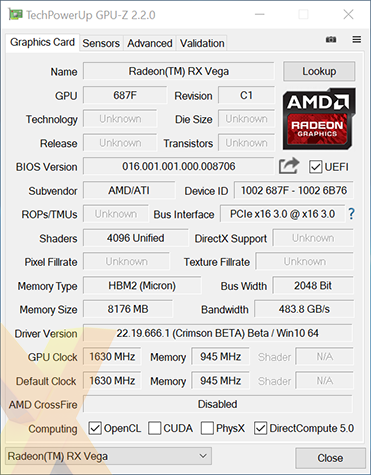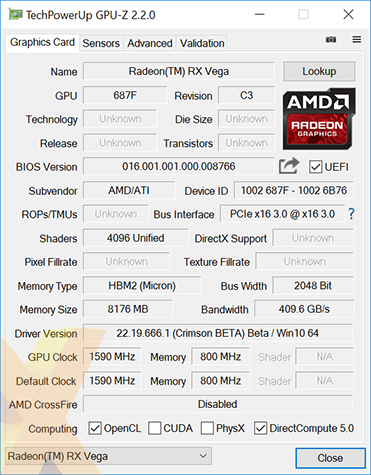Test Methodology
AMD Radeon RX Vega 64 Specification |
AMD Radeon RX Vega 56 Specification |
|---|---|
 |
 |
GPU Comparisons |
||||||||||
|---|---|---|---|---|---|---|---|---|---|---|
GPU |
Memory |
Miscellaneous |
||||||||
Cores |
Base (MHz) |
Boost (MHz) |
Type |
Size (MB) |
Clock (MHz) |
Bus (bits) |
Power Config |
Driver |
||
| Nvidia Titan Xp | 3,840 |
1,405 |
1,582 |
GDDR5X |
12,288 |
11,408 |
384 |
8+6 |
384.76 |
|
| EVGA GeForce GTX 1080 Ti SC2 | 3,584 |
1,557 |
1,671 |
GDDR5X |
11,264 |
11,008 |
352 |
8+8 |
384.94 |
|
| EVGA GeForce GTX 1080 FTW | 2,560 |
1,721 |
1,860 |
GDDR5X |
8,192 |
10,008 |
256 |
8+6 |
384.94 |
|
| Nvidia GeForce GTX 1070 FE | 1,920 |
1,506 |
1,683 |
GDDR5 |
8,192 |
8,008 |
256 |
6+6 |
384.94 |
|
| AMD Radeon RX Vega 64 | 4,096 |
1,247 |
1,546 |
HBM2 |
8,192 |
945 |
2,048 |
8+8 |
17.8.1 |
|
| AMD Radeon RX Vega 56 | 3,584 |
1,156 |
1,471 |
HBM2 |
8,192 |
800 |
2,048 |
8+8 |
17.8.1 |
|
| AMD Radeon R9 Fury X | 4,096 |
- |
1,050 |
HBM |
4,096 |
500 |
4,096 |
8+8 |
17.7.2 |
|
| Sapphire Radeon RX 580 8GB Nitro+ LE | 2,304 |
- |
1,450 |
GDDR5 |
8,192 |
8,000 |
256 |
8+6 |
17.6.1 |
|
HEXUS Graphics Test Bench |
||
|---|---|---|
| Hardware Components | Product Page | |
| Processor | Intel Core i7-6700K (overclocked to 4.4GHz) | intel.com |
| CPU Cooler | Noctua NH-D15S | noctua.at |
| Motherboard | Asus Z170 Pro | asus.com |
| Memory | Crucial Ballistix Sport LT 32GB (2x16GB) DDR4-2400 | crucial.com |
| Power Supply | be quiet! Dark Power Pro 11 850W | bequiet.com |
| Primary Storage | 256GB Samsung 950 Pro | samsung.com |
| Secondary Storage | 512GB SK hynix Canvas SC300 | skhynix.com |
| Chassis | Fractal Design Define R5 Windowed | fractal-design.com |
| Monitor | Philips Brilliance 4K Ultra HD LED (288P6LJEB/00) | philips.co.uk |
| Operating system | Windows 10 (64-bit) | microsoft.com |
Benchmark Suite |
||
|---|---|---|
| Synthetic Benchmarks | ||
| 3DMark | Fire Strike, Fire Strike Extreme, Fire Strike Ultra, Time Spy and Time Spy Stress Test | |
| VRMark | Orange Room and Blue Room | |
| Gaming Benchmarks and Settings | ||
| Deus Ex: Mankind Divided | DX12, TAA, Ultra Quality | |
| Doom | Vulkan, TSSAA (8TX), Ultra Quality | |
| Gears of War 4 | DX12, TAA, Ultra Quality | |
| Hitman | DX12, SMAA, Ultra Quality | |
| Rise of the Tomb Raider | DX12, SMAA, Very High Quality | |
| Total War: Warhammer | DX12, FXAA, Ultra Quality | |
| General Benchmarks | ||
| Power Consumption | To emulate real-world usage scenarios, we record system-wide mains power draw both when idle and while playing Gears of War 4. | |
| Temperature | To emulate real-world usage scenarios, we record GPU core temperature both when idle and while playing Gears of War 4. | |
| Noise | A PCE-318 meter is used to record noise levels when idle and while playing Gears of War 4. | |
| Overclocking | Maintaining out-the-box voltage, we increase the card's power target and aim for an optimal balance of core and memory overclock. | |
Notes
To minimise the impact of any CPU bottlenecks, our test platform is configured with a quad-core Intel Core i7-6700K processor overclocked to 4.4GHz across all cores and 32GB of Crucial Ballistix Sport LT DDR4 memory set to run at 2,400MHz using the built-in XMP profile.
For our high-end benchmark suite, we have an array of games tested at FHD (1,920x1,080), QHD (2,560x1,440) and 4K UHD (3,840x2,160) resolutions. Where applicable, any vendor-specific enhancements such as PhysX and TressFX are disabled to help even the playing field. In-game benchmark results are recorded as average frames per second and minimum fps is included where available.
We have tested a bunch of cards from scratch and, keeping it relevant, have the GeForce GTX 1080 and GTX 1070 as direct comparisons.









